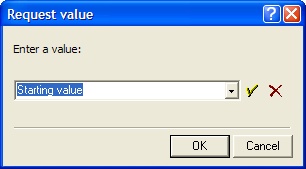
GetValue
The GetValue function opens a dialog to request a string (or a value). If you click [OK], the entered string is saved to a history list and is returned. The current string is shown in the edit field of the list box. The remaining items in the list box show a history of strings that have been recently used and which may be selected. This function is similar to GetString except that a history list is maintained.
|
|
|
sStr, bSuccess = GetValue()
sStr, bSuccess = GetValue( s )
sStr, bSuccess = GetValue( s, sPrompt )
sStr, bSuccess = GetValue( s, sPrompt, sTitle )
sStr, bSuccess = GetValue( s, sPrompt, sTitle, sRegistry )
sStr, bSuccess = GetValue( s, sPrompt, sTitle, sRegistry, sTooltip )
where
![]() s is the initial string. If nil, a blank string is
used.
s is the initial string. If nil, a blank string is
used.
![]() sPrompt is the message above the string field.
If nil, a default is
used.
sPrompt is the message above the string field.
If nil, a default is
used.
![]() sTitle is the window title. If nil, a default is used.
sTitle is the window title. If nil, a default is used.
![]() sRegistry is the key for the history list in
the Windows Registry. If nil, the default registry is used.
sRegistry is the key for the history list in
the Windows Registry. If nil, the default registry is used.
![]() sTooltip is the string for a popup Tooltip. If
nil, no Tooltip is
used.
sTooltip is the string for a popup Tooltip. If
nil, no Tooltip is
used.
![]() bSuccess is an optional success flag.If
[OK] is clicked,
the string sStr is returned
and bSuccess=true. If the dialog is canceled,
"", false is returned.
bSuccess is an optional success flag.If
[OK] is clicked,
the string sStr is returned
and bSuccess=true. If the dialog is canceled,
"", false is returned.
All arguments are optional and assume default values beyond the last argument you specify. To use a default argument but follow it with a specified argument, use a nil in its place.
This function maintains a history list in the Windows registry. By choosing different names for the sHistory argument, you can have different history lists for different instances of the dialog. If [OK] is clicked, the string is added to the history list and returned as the value sStr.
Although this function returns a string, it can also be used to fetch numbers. After the function returns, the calling module can convert sStr to a number using the Lua function tonumber(). Of course, Lua allows implicit conversion; when a number is needed but a string form of the number exists, Lua will automatically attempt to convert the string to a number.
The window shown above was created using the following code. The initial value displayed in the edit field is passed as "Starting value":
|
|
-- initial value is specified |
|
|
|